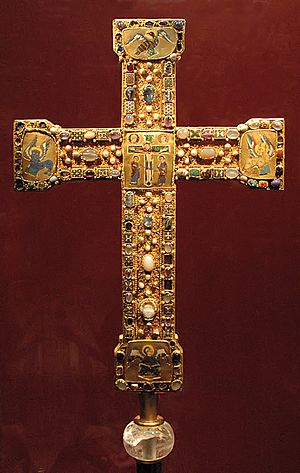Ottonian Renaissance facts for kids
The Ottonian Renaissance was a special time in Europe when art, learning, and culture became very important again. It happened during the rule of the first three emperors from the Ottonian family: Otto I (936–973), Otto II (973–983), and Otto III (983–1002). These emperors, also known as the Saxon dynasty, strongly supported this rebirth of ideas.
Important people like Pope Sylvester II and Abbo of Fleury were leaders in this movement. The Ottonian rulers connected with the Byzantine city of Constantinople. This led to a mix of Eastern-Byzantine and Western-Latin styles, especially in art, buildings, and metalwork. The Ottonians also improved schools connected to cathedrals, where people learned about the seven liberal arts. Much of the learning during this time continued ideas from the earlier Carolingian Renaissance.
Contents
A Time of New Beginnings
The idea of a "renaissance" for the Ottonian period was first used by a German historian named Hans Naumann in 1927. This period is one of three important "medieval renaissances."
The Ottonian Renaissance truly began after King Otto I married Adelaide of Italy in 951. This marriage brought the kingdoms of Italy and Germany together. It also helped the West connect more closely with the Byzantine Empire. Otto I further strengthened Christian unity when he was crowned Emperor by the Pope in 962 in Rome.
Sometimes, this period is also called the Renaissance of the 10th Century or the Year 1000 Renewal. It was shorter than the Carolingian Renaissance that came before it. Many historians see it as a continuation of the Carolingian period, sometimes calling it a "third Carolingian renaissance."
Learning and New Ideas
During the Ottonian Renaissance, there was a strong focus on learning. Libraries grew bigger thanks to the hard work of monks who copied books by hand. For example, the library at Bobbio Abbey had almost 600 books! Gerbert, who later became Pope Sylvester II, helped build the collection at Bobbio.
Scholars were very interested in subjects like arithmetic, geometry, music, and astronomy.
Important Scholars and Their Discoveries
- Abbo of Fleury wrote many books about calculating time and understanding the movements of the sun, moon, and planets. He also created a list of stars.
- The future Pope Sylvester II brought new tools for learning. He used wooden globes to study how the Earth, planets, and stars move. He also used a tool called a monochord for music studies and an abacus for math.
- Fulbert of Chartres introduced the use of Arabic numerals, which are the numbers we use today (0, 1, 2, 3, etc.).
- Hermann of Reichenau, from the Reichenau school, was famous for his writings on the astrolabe (a tool for astronomy), calculus (a type of math), and music.
Art and Architecture
The Ottonian Renaissance is most famous for its amazing art and architecture. This artistic burst was fueled by new connections with Constantinople and by strong cathedral schools, like the one led by Archbishop Bruno of Cologne.
Artists created beautiful illuminated manuscripts (hand-copied books with colorful pictures). These were often made in special workshops called scriptoria. Some famous scriptoria were at Quedlinburg Abbey and Reichenau Island. The Codex Egberti is a great example from Reichenau. It shows stories from the life of Christ, mixing styles from the Carolingian period, and even some Byzantine influences. Other well-known manuscripts include the Reichenau Evangeliary and the Pericopes of Henry II.
The art of this time was often made for the emperors and the church. It aimed to show that the emperors had a special, holy connection to power, like the ancient Roman emperors. Ottonian art blended styles from ancient Rome, the Carolingian period, and the Byzantine Empire.
The architecture of this time was also new and exciting. It set the stage for the later Romanesque style.
Women's Influence in Art and Culture
The Imperial court became a center for religious and cultural life. Women in the royal family played a big role. Matilda, Otto I's mother, was very educated. His sister Gerberga of Saxony and his wife Adelaide of Italy also had a strong influence.
The Byzantine influence grew even more when Otto II married Princess Theophanu. After her husband died in 983, Theophanu ruled as empress for her young son, Otto III, until 991. She brought many Byzantine ideas and symbols to the West. For example, the globus cruciger (a globe with a cross on top) became a symbol of royal power. Emperors were often shown crowned by Christ, in the Byzantine way.
Otto III even tried to bring back the "glory that was Rome." He made Rome his capital and increased the grand ceremonies of the court, inspired by Greek and Roman traditions.
Key Figures of the Ottonian Renaissance
Many important people shaped this period:
- Bernward of Hildesheim
- Hroswitha of Gandersheim – a nun who wrote poetry and plays based on classical works.
- Otto I, Otto II, Otto III, and Henry II – the emperors who supported this cultural rebirth.
- Hermannus Contractus
- Gerbert of Aurillac – who became Pope Sylvester II.
- Theophanu – the Byzantine empress.
- Liutprand of Cremona – a historian who wrote about Otto I.
- Bruno I, Archbishop of Cologne
- Widukind of Corvey – another historian of the time.
- Adelaide, Abbess of Vilich
- Egbert, Archbishop of Trier
Images for kids
See also
- Ottonian art
- Ottonian architecture




